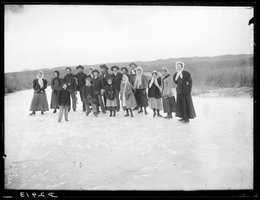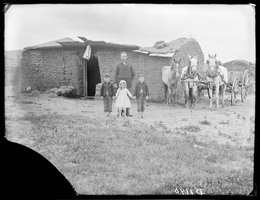

Settlers knew that the federal government was making free land available, but what about the weather on the Great Plains? Weather controlled the conversations of farmers in the East. The weather would affect life on the “new land” — and it still does.
Since Nebraska is in the middle of the continent, there are extremes of weather here that do not happen on the coasts. Every group of people who have lived here have had to find ways to cope and even thrive — because the same storm that produces a blizzard can leave behind a natural ice rink on one of the many Sandhills lakes.
When they got to the plains, some early visitors thought the weather was worse than they had experienced before. John T. Gibson was a traveler on the Oregon Trail in 1859. He wrote in his diary about "the father of all the thunderstorms" that he encountered on May 26, 1859 near present day Kearney. He said, "the full force of the rain storm fell upon their devoted heads and drenched them to the skin."

Earlier, Gibson had compared storms on the Plains to those he was familiar with:
“Talk about your eastern rainstorms. They sink into utter insignificance when compared with what can be got up on short notice along the Platte. The lightening flashed almost simultaneous with the clashing, deafening, reverberating reports of heaven’s artillery. The wind howled a perfect tornado, leveling one tent in company, and forcing the inmates to scamper in their shirt-tails and seek shelter in ours.”
Mrs. John Grosvenor lived through the Easter Blizzard of 1873. Sixty years later, she told an interviewer for the WPA how her father moved the horse in the house with the family and moved the cow and calf into the lean-to kitchen to keep them alive.

In a sod house it was very difficult to get away from the weather or the environment around you. You often couldn’t keep the outside out!
For instance, the roofs of many sod houses were never really waterproof. Roofs were usually relatively shallow. If they were too steep, the sod would slip off or the gable end walls of the house would get too high and might collapse. Also a steeper roof required longer timbers which were hard to come by. So, builders tended to keep sod roofs shallow. In addition, the sod in much of Nebraska has a lot of sand in it which makes the sod permeable. Shallow roofs that don’t shed water quickly added to sod that soaks up water means many roofs leaked. Often, after a heavy rainstorm, the soaked roof would drip for several days and the family would be warmer and drier outside than inside their own homes.
George Barnes had many more problems than a leaky roof in 1887. The year before this picture was taken, his wife died leaving him to raise their three kids. The night before Solomon Butcher took this picture, a driving rain had soaked his sod roof. The ridgepole had decayed over the years, possibly because the roof leaked. The added weight of drenched sod was too much, and his roof collapsed 10 minutes after he and the children got out of bed. They were all safe, but the house was buried in mud and lumber.
Leaking roofs could also be a day-to-day annoyance. Mrs. H. C. Stuckey remembered how the rain would affect her cooking.
“From hardly any rain we soon had more than we needed. Our roof would not stand the heavy downpours that sometimes contuned [sic] for days at a time, it would leak from one end to the other. We could keep our beds comparatively dry by drawing them into the middle of the room directly under the peak of the roof. Sometimes the water would drip on the stove while I was cooking, and I would have to keep tight lids on the skillets to prevent the mud from falling into the food. With my dress pinned up, and rubgers [sic] on my feet, I waded around until the clouds rolled by. Then we would clean house. Almost everything had to be moved outdoors to dry in the sun. Life is too short to be spent under a sod roof.” — From History of Custer County, Nebraska by W.L. Gaston and A.R. Humphrey, 1919.
Homesteader Uriah Oblinger wrote to his wife Mattie about an Easter snowstorm that lasted for nearly 80 hours in 1873. He told about going out in the storm to help a neighbor lady who lived about a mile from him. She was out of wood and her ax was buried in the snow. She and her four children had resorted to breaking up furniture in the house to use for cooking and keeping warm. Uriah helped find her ax and cut down some poles from the pigpen to use for firewood.
In his letter, Uriah also talks about the snow streaming into the house through every crevice. This is one reason that almost every sod house was plastered inside. Another was that crevices or holes in the wall were inviting homes for fleas, rats, mice, and snakes. Sod house builders would let the walls settle for six weeks or more. Then they would smooth the walls and coat them with commercial or home-made plaster to fill in the holes.
Snake stories were common in pioneer stories and reminiscences, as were home remedies for rattlesnake bites. H. W. Sample told about his experiences with snakes when he was a child living near Roseland Nebraska in the 1880s. As you read this story it might be good to remember that tall tales were also popular during this time.
How does the story about the snakes help show what life was like living on the frontier and in a sod house?
Do you believe the stories about the snakes? Why or why not?
Do rattlesnakes still live in Nebraska?
How would living in a sod house be different than living in the home you have today?